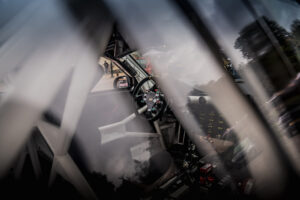What happens to a race car when its natural career ends? If it’s lucky, it gets a second lease of life as a historic racer.
If you read our feature on the Prodrive-built Aston Martin Vantage GTE, you’ll know that the classes that define sports car racing can get fairly convoluted.
Take this Porsche 911. In the late 2000s, it ran in what’s fundamentally the same GTE category as that Aston, but at the time the class was called GT2 to signify that it sat below the now-defunct GT1 category. So far, so simple.
Wading into the equation, however, comes the Porsche 911’s typically arcane model range. This is the 997-generation Porsche 911 GT3 RSR. GT3, you’ll note, isn’t the category this car competes in – it’s just based on the roadgoing 911 GT3, a model that was introduced to homologate the 911 for racing before the actual GT3 category even existed.
To further the confusion, the turbocharged roadgoing 997-generation 911 GT2 that arrived in 2007 had nothing to do with racing, and simply sat above the GT3 in the model range.
To summarise: the 997 GT3 was the base for both GT3 and GT2 race cars, and the 997 GT2 didn’t race at all even though it was named after the category this GT3 raced in. Argh.
Let’s forget the deeply convoluted nomenclature, and focus instead on what this is: a no-holds-barred Porsche 911 racing car. The 997 RSR made use of a name that’s been reserved for the ultimate racing 911s over the decade. It debuted on 1972’s 911 RSR, a car that tackled everything from tarmac rallies to 24-hour endurance races.
Those three vaunted letters stand for ‘RennSport Rennwagen’, literally ‘Racing Sport Race Car’. That’s a clunky name for a very much not-clunky car. The name has reappeared on racing versions of every subsequent generation of 911, including this 997.
Power – 460bhp of it – came from a race-bred, 3.8-litre version of the legendary naturally-aspirated ‘Mezger’ flat-six that powered every roadgoing GT3 and GT3 RS of the 996 and 997 generations. Elsewhere, it’s business as usual for a GT2 race car – this is pretty far removed from the 997 GT3 road car.
This particular car spent its competitive career racing in the American Le Mans Series, where VICI Racing ran two part-time campaigns. It first raced in 2008, and wore this T-Mobile livery throughout most of the 2009 season.
One of the seats for the season was occupied for every race by Johannes Stuck, the son of former F1, DTM and sports car racer Hans-Joachim Stuck. Hans-Joachim was on board to co-drive with his son, alongside Dutch racer Nicky Pastorelli, for the 2009 season-opening 12 Hours of Sebring. After qualifying 22nd overall, however, the car never started the race for reasons that seem to have been lost to the mists of time.
It contested a further four races that season, at Long Beach, Utah, Lime Rock and Laguna Seca. Brit Richard Westbrook co-drove at every race except for Utah, where Pastorelli took the wheel.
The VICI car was remarkably consistent in its results, finishing in 11th at three of those four races and rounding out the season with a 12th at Laguna Seca. However, since it didn’t race a full season, it wasn’t eligible for championship points.
Perhaps not the most auspicious career in period then, but fast forward to the present day, and the car, now in private hands, has wound up in Pursuit Racing’s care. Over the winter of 2021 and 2022, Pursuit’s founder Oli Cable and his team treated the 997 to a full rebuild.
The constantly evolving timeframe that defines ‘historic’ means that this car, though it still feels comparatively modern, is eligible for a host of historic racing series. After a 2022 testing programme, this is exactly where it’ll end up. The brilliance of historic racing is that it gives cars like this – even if they represent a relatively small part of motorsport history – a second lease of life. Instead of being quietly forgotten about in a museum or a private collection somewhere, they’re given the opportunity to get back where they belong – out on the track, being driven hard, and looking and sounding rather good doing it.














